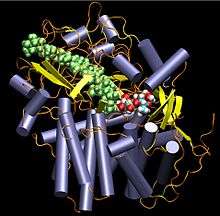Cellulose 1,4-beta-cellobiosidase (reducing end)
| Cellulose 1,4-beta-cellobiosidase (reducing end) | |||||||||
|---|---|---|---|---|---|---|---|---|---|
| Identifiers | |||||||||
| EC number | 3.2.1.176 | ||||||||
| Databases | |||||||||
| IntEnz | IntEnz view | ||||||||
| BRENDA | BRENDA entry | ||||||||
| ExPASy | NiceZyme view | ||||||||
| KEGG | KEGG entry | ||||||||
| MetaCyc | metabolic pathway | ||||||||
| PRIAM | profile | ||||||||
| PDB structures | RCSB PDB PDBe PDBsum | ||||||||
| |||||||||

A simulation of CelS, Oak Ridge National Laboratory
Cellulose 1,4-beta-cellobiosidase (reducing end) (EC 3.2.1.176, CelS, CelSS, endoglucanase SS, cellulase SS, cellobiohydrolase CelS, Cel48A) is an enzyme with systematic name 4-beta-D-glucan cellobiohydrolase (reducing end).[1][2] This enzyme catalyses the following chemical reaction
- Hydrolysis of (1->4)-beta-D-glucosidic linkages in cellulose and similar substrates, releasing cellobiose from the reducing ends of the chains.
The CelS enzyme from Clostridium thermocellum is the most abundant subunit of the cellulosome formed by the organism.
References
- ↑ Barr, B.K.; Hsieh, Y.L.; Ganem, B.; Wilson, D.B. (1996). "Identification of two functionally different classes of exocellulases". Biochemistry. 35: 586–592. doi:10.1021/bi9520388. PMID 8555231.
- ↑ Saharay, M.; Guo, H.; Smith, J.C. (2010). "Catalytic mechanism of cellulose degradation by a cellobiohydrolase, CelS". PLOS ONE. 5: #e1294–e1294. doi:10.1371/journal.pone.0012947. PMC 2953488
 . PMID 20967294.
. PMID 20967294.
External links
- Cellulose 1,4-beta-cellobiosidase (reducing end) at the US National Library of Medicine Medical Subject Headings (MeSH)
This article is issued from Wikipedia - version of the 11/10/2016. The text is available under the Creative Commons Attribution/Share Alike but additional terms may apply for the media files.